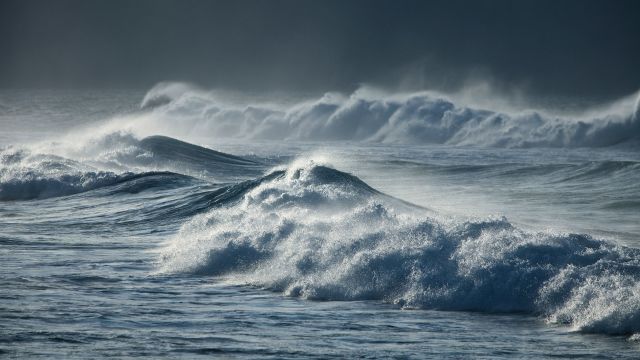From the alii of Hawaii nei riding koa boards along the Waikiki break, to athletes competing in big-time events on Oahu’s North Shore, to everyday enthusiasts catching a morning wave—surfing is one of the Aloha state’s most awe-inspiring traditions.
Still, as with any open water sport, surfing comes with risk. Besides drowning hazards, surfers can run afoul of coral reefs or even their own boards.
“I patch up a lot of dinged heads, dinged faces, dinged arms cut by the skeg (or fin) from the leash pulling back,” says veteran Waikiki lifeguard Captain Paul Merino.
But the stakes are even higher when a tropical storm or hurricane approaches the islands and die-hard surfers paddle out to catch big waves.
Regular surf vs. hurricane waves
Hawaii’s beaches tend to have relatively consistent seasonal wave patterns when no storms are present. On Oahu, the North Shore gets big waves in the winter while the South Shore sees larger summer swells. These waves are formed by large storms, including hurricanes, that occur thousands of miles from Hawaii. They travel across the Pacific before making their way to local beaches.
“There's a long time for those waves to manicure themselves, with the wind blowing on them, and as they travel, they separate and become epic waves,” says Merino. These are the waves surfers love.
Hurricane waves, on the other hand, are an altogether different beast. In a hurricane, winds generate quick waves that are very close together and have a lot of white water.
“It can be like being in a washing machine because the winds, they're just pushing and pushing and pushing the water,” says Eric Lau, meteorologist with the National Weather Service Pacific Region in Honolulu. “So, when you don't have a lot of time for the waves to set up, they're going to be really short.” Short waves lead to more white water, which makes paddling out and catching them nearly impossible.
Besides heavy surf, the high winds from hurricanes may send objects like coconuts or broken branches flying through the air, warns Lau. Hurricanes can also generate waterspouts and tornadoes that increase their danger, he adds.
Hurricanes generate larger volumes of water at the shoreline, too, which causes beach erosion. “These waves continue to push white water into the beach and it piles up higher than normal onto the sand and erodes the sand as it comes back into the water,” says Merino. “It creates a very, very dangerous current close to shore.”
Hazards beneath the waves
Rough weather isn’t the only threat posed by hurricanes. Surfers also have to consider that they’re not alone out there. Merino admits that in his youth, he couldn’t resist the allure of trying to surf Waikiki—especially when Hurricane Iniki grazed Oahu and hit Kauai in 1992. He and his surf partner paddled out at Waikiki beach in 15- to 20-foot waves on 12-foot boards thinking, “We'll make history to ourselves.”
Before they could catch their first wave, however, they ran into another hurricane hazard. Merino recounts: “The most scary thing of that day, Hurricane Iniki, was that the largest shark I've ever seen in my life came right up to my surfboard and checked me out. That was our sign to get out of the water.”
Merino’s experience wasn’t uncommon. Large predators may show up amidst the churning water and debris, according to both Merino and Lau.
Who surfs a hurricane, anyway?
Between high winds, short waves, strong currents and curious predators, surfing big storms is more dangerous than pursuing everyday waves. So, what’s the appeal?
One theory: Big storms bring out thrill seekers in the surf community. As one storm surfer who wished to remain anonymous said, “Surfing is never completely safe. That’s the thrill of it.”
Thankfully, storms tend to keep would-be surfers from getting into too much trouble. “Hurricane surf manages the surfers, because it pushes them back in,” says Merino. The strong winds and fast waves generally require an expert surfer to catch a wave. Everyone else gets ushered back to shore.
Post-hurricane hazards
Hawaii hurricane dangers don’t end when the storm dies out. Brown water is common following any heavy rainfall in the state.
What is brown water? It’s runoff from any large storm that may contain sewage with harmful microorganisms and chemicals from industrial or commercial use, according to the Hawaii State Department of Health.
“From all that water washing down in heavy rain, there could be dead animals that flow down, or pesticides that get washed out,” Lau adds.
Fortunately, the Department of Health issues brown water advisories, so you know what areas to avoid. Check them out at the Clean Water Branch.
If in doubt, don’t go out
Hawaii’s hurricane season starts on June 1 and runs through November 30. According to Lau, the islands usually see around four to five large storms each year.
During these storms, local government agencies will close beaches and issue advisories as the conditions require. Always be mindful of warning signs posted on beaches and stick to those areas that have a lifeguard present. Remember that if you do get in the water despite warnings, you may be putting more than your own life at risk.
“We warn the public the best we can with signage and verbal warnings,” says Merino. “But there are those who do go down to the shoreline. They get sucked in, and now we are risking our lives to go in and pull them out.”
The best practice when deciding whether or not to get in the water is to follow the lifeguard’s credo: If in doubt, don’t go out.
Sources:
National Weather Service / National Oceanic and Atmospheric Administration. “Hurricane Hazards.” 2021. Accessed May 6, 2021.
National Ocean Service. “How do hurricanes affect sea life?” February 26, 2021. Accessed May 7, 2021.
Hawaii State Department of Health: Clean Water Branch. “Current Water Quality Advisories: General Health Advisory.” 2021. Accessed May 6, 2021.






